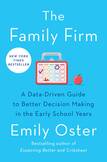Review: How to apply principles of economics to parenting
The Brown University economist Emily Oster, author of the best-selling Expecting Better (2013) and Cribsheet (2019), is back with a third book on how to apply the principles of economics to parenting.
In The Family Firm, Oster wades through the data on questions relevant to many parents of school-age kids: extracurriculars, camp, sleep and so on. But the book is less about the data itself and more about how to frame decisions on these topics and others in the most effective, logical and efficient way using what Oster calls the “four F’s”—frame the question, fact-find, final decision and follow up. Oster encourages parents to have a “mission statement” for their families, just like they would for any firm where they do paid work, and then apply the four F’s to a given decision through the lens of that overarching ambition. Throughout the book, Oster uses both examples from her own life with two children and hypothetical scenarios to demonstrate the practicability and virtues of this decision-making process.
Implicit in Oster’s guidance is the understanding that family life requires the same explicit articulation of purpose and goals as any professional endeavor. The fact that many view parenting as sacred work does not render that work any less subject to the imperatives of, say, cost-benefit analysis than any other kind of work. You cannot add one more product line to your business’s repertoire without a foundational knowledge of the product’s production costs and its likely sale value, as well as your firm’s long-term mission and its short-term priorities. Neither can you add one extracurricular activity to your family’s weeks without a clear sense of the commitment required (and its likely duration and trajectory), as well as the specific mission and goals unique to your own “family firm.”
Hooray for the data on parenting—and forget about the sacred cows.
In me Oster has an enthusiastic cheerleader and a willing (if still sometimes wanting) disciple. My dad is a social scientist, too, and I am a good student. So long before I became a parent or even heard of Oster, I was striving to focus on data filtered through the lens of my values and separated from the impetus of my emotions to make decisions about family life and about everything else.
So I find Oster’s broad guidance on parenting useful in many ways. Economically based parental decision-making? Check! Been there, been doing that. As I wrote in an earlier piece on Cribsheet(“The End of Parenting,” 11/25/19), Oster’s guidance on early parenting hot topics like breastfeeding, screen time and sleep training gave me a succinct counterweight to any lingering, irrational guilt over making what had in fact been the optimal decisions for my family. Hooray for the data—and forget about the sacred cows.
Yet, for me, Oster’s guidance in The Family Firm is more humbling than validating. Compared with the cool, comprehensive deliberation Oster describes taking place in her household, my own discernment often seems irreducibly conflicted, and in ways that Oster’s decision-making framework cannot always solve.
I am a controlling person. I am the kind of mom that puts hard caps on the number of Christmas presents my kids receive and schedules everything in advance. Yet if my son wanted to try out for his elementary school’s musical, it would not cross my mind to say anything other than “good luck,” and worry about any frustrating but temporary wrenches to my preferred family schedule afterward.
I am impressed by Oster’s consistent adherence to her family mission and priorities, as well as by her confidence in her method.
Oster approached the same situation quite differently. She ran a decision about her daughter’s participation in the school production of “Frozen” through the “four F’s” the way I would have run a decision about something much more persistently time-consuming, less seasonal and less communally oriented—like travel basketball or youth orchestra. Her daughter did not try out for the play; it would have conflicted for a time with one of Oster’s priorities: family dinner, nightly at six o’clock.
This anecdote leaves me impressed, troubled and jealous.
I am impressed by Oster’s consistent adherence to her family mission and priorities, as well as by her confidence in her method. And I am challenged to be more intentional about drawing firmer and more frequent boundaries around my family’s priorities, rather than reflexively saying yes to things, or sliding into commitments that do not serve our broader family mission.
Simultaneously, though, I am troubled by the implicit presumption in this anecdote and throughout the book that most parents have options when it comes to things like extracurriculars. It is true that most of Oster’s readers likely do have multiple and competing opportunities—but, of course, many people do not. For those without the kinds of privileges that Oster’s family and mine enjoy, choosing among extracurricular options might not be a consideration, because access to even one worthwhile, affordable activity is the more pressing concern.
Finally, I am jealous because part of me craves the kind of total independence that Oster demonstrates in this story—the kind of control I had when I dumped the breast pump and broke out the formula. There is a simple antidote to my jealousy, of course: If I want to prioritize a few weeks of nuclear family dinner over something like the school play, I can. Just as I can prioritize my baby’s nap time over a family party; my 4-year-old’s healthy eating over a meal with his grandmother; or my 6-year-old’s “total responsibility” for getting himself ready for school sans scaffolding (the way Oster suggests transferring tasks) over the rest of us being on time.
But it turns out that for my husband and me, that kind of total autonomy is incompatible with the way in which we are choosing to live out our family mission. That is, we are constrained by the professional, geographic and educational decisions we have already made, and the spirit in which we have made them.
We have chosen, over and over, not to be a nuclear family firm.
I could picture choosing differently and pursuing our broader family mission in a less conventional, more iconoclastic way. Like homeschooling my kids. Or moving far away from family and friends. Or instead of taking multigenerational, family-focused trips to the Jersey shore and Ohio, taking nuclear family excursions to distant ski resorts. There are great reasons why many people make these choices, of course, and I could imagine circumstances under which I might make any or all of them myself.
But what I cannot imagine is having chosen to be part of a school community or part of an extended family and then choosing to defer to our toddler’s bedtime or our family dinner hour over a given (temporary, bounded, communally central) event. Because those very disruptions to our nuclear family priorities are at the heart of our macro-level mission: to teach our young sons that our nuclear family, though the center of our world, is not the center of the world. Rather, it is a sacred means to the holy end of walking with and serving others.
To accomplish this mission feels daunting, even unlikely in a world where “parenting alone” is the emerging norm. And despite my quibbles with the book’s limitations and my frustration with the ways in which it reveals my own, The Family Firm is a resource worth having on that journey.
This article also appeared in print, under the headline “Data-Crunching for Parents,” in the November 2021, issue.









